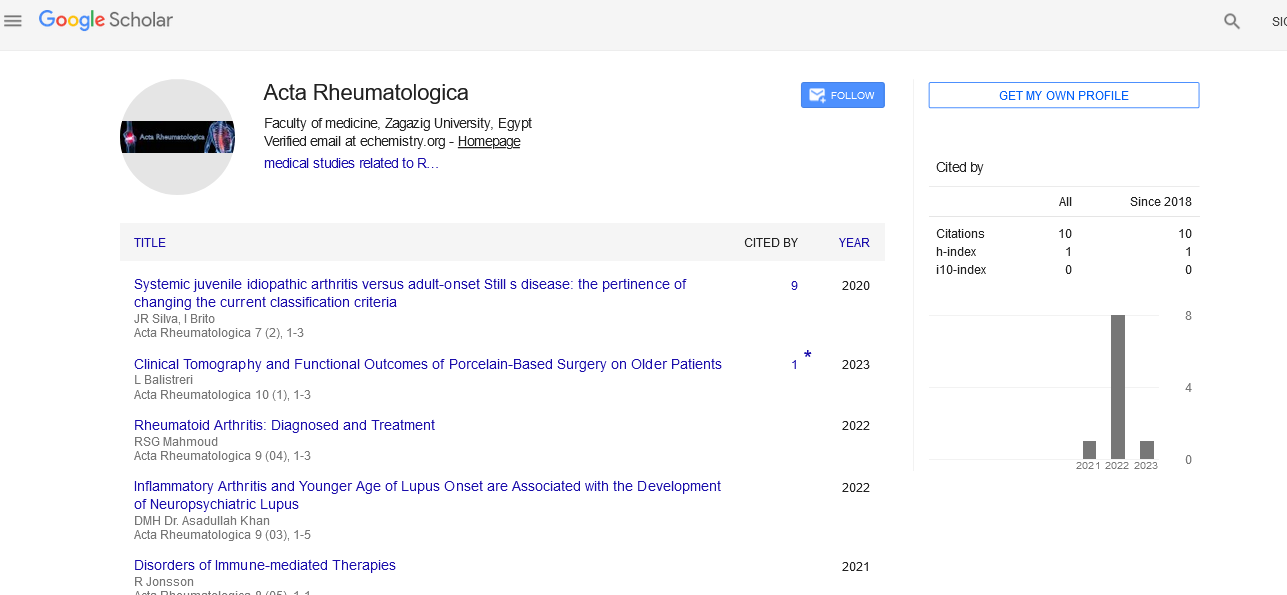Perspective - (2023) Volume 10, Issue 5
Bones: The Foundation of the Human Body
Carlos Sastre*
Department of Clinical Microbiology, National Taiwan University, Taiwan
*Correspondence:
Carlos Sastre, Department of Clinical Microbiology, National Taiwan University,
Taiwan,
Email:
Received: 01-Sep-2023, Manuscript No. ipar-23-14258;
Editor assigned: 04-Sep-2023, Pre QC No. ipar-23-14258 (PQ);
Reviewed: 19-Sep-2023, QC No. ipar-23-14258;
Revised: 27-Sep-2023, Manuscript No. ipar-23-14258 (R);
Published:
05-Oct-2023
Introduction
Bones are the structural cornerstone of the human body,
providing support, protection, and facilitating movement.
While they are commonly recognized for their rigid
framework, bones are living tissues that continuously
adapt and renew themselves. Understanding the anatomy,
functions, and the intricate processes that maintain bone
health is crucial for overall well-being. This article aims to
delve into the diverse aspects of bones, exploring their
composition, functions, growth, and the importance of
maintaining bone health.
Anatomy of bones
Bones are comprised of an intricate matrix of collagen, a
protein providing flexibility, and mineral deposits mostly
calcium and phosphorus contributing to their hardness
and strength. This combination results in a solid yet
flexible structure that can withstand significant stress and
weight. The human skeletal system consists of 206 bones,
each categorized into five main types: long, short, flat,
irregular, and sesamoid bones. These bones vary in shape,
structure, and function, collectively providing support,
protection, and enabling movement.
Functions of bones
Support and structure: Bones form the scaffolding that
supports the body's weight, providing the framework that
muscles and organs rely on.
Protection: Bones act as protective shields for vital
organs, such as the skull safeguarding the brain or the rib
cage protecting the heart and lungs.
Movement: Joints and muscles work in tandem with
bones, allowing coordinated movement, flexibility, and
dexterity.
Blood cell formation: The bone marrow within bones is
responsible for producing red blood cells, white blood
cells, and platelets, essential for immunity and blood
clotting.
Mineral storage: Bones store essential minerals like
calcium and phosphorus, releasing them into the
bloodstream when needed for other bodily functions.
Bone growth and remodeling
Throughout life, bones undergo a continuous cycle of
growth, remodeling, and regeneration. During childhood
and adolescence, the growth plates at the ends of long
bones allow for growth in length. This process ceases once
an individual reaches skeletal maturity. However, bones
continue to remodel, adapting to stress and repairing
damage through a process called bone turnover.
Osteoclasts break down old bone tissue, while osteoblasts
form new bone, ensuring a constant cycle of regeneration
and maintenance.
Description
Maintaining bone health
Nutrition: Calcium, phosphorus, vitamin D, and other
nutrients are vital for bone health. A balanced diet rich
in these elements supports bone strength.
Weight-bearing exercise: Regular weight-bearing
exercises such as walking, running, or resistance training
help in maintaining bone density and strength.
Avoiding harmful habits: Limiting alcohol consumption,
avoiding smoking, and reducing excessive caffeine intake
positively impact bone health.
Regular check-ups: Periodic bone density tests and
check-ups are essential, especially for individuals at risk
of bone-related conditions like osteoporosis.
Supplements when necessary: In certain cases, doctors
might recommend supplements like calcium or vitamin
D for those who cannot obtain enough from their diet.
Common bone-related conditions
Osteoporosis: A condition characterized by weakened,
porous bones, increasing the risk of fractures.
Fractures: A break in the bone, varying in severity from
a hairline crack to a complete break.
Arthritis: Various types of arthritis, such as osteoarthritis and
rheumatoid arthritis, affect the joints and can influence the
health of the bones over time.
Bone infections: Infections like osteomyelitis can affect the
bones, leading to inflammation and potential damage.
Terminology
In the investigation of life structures, anatomists utilize
various physical terms to depict the appearance, shape and
capability of bones. Other physical terms are likewise used
to portray the area of bones. Like other physical terms, a
considerable lot of these get from Latin and Greek. A few
anatomists actually utilize Latin to allude to bones. The
expression "bony", and the prefix "osteo-", alluding to
things connected with bone, are as yet utilized normally
today. A few instances of terms used to portray bones
incorporate the expression "foramen" to depict an opening
through which something passes, and a "trench" or
"meatus" to portray a passage like design. A distension from
a bone can be known as various terms, including a
"condyle", "peak", "spine", "distinction", "tubercle" or
"tuberosity", contingent upon the projection's shape and
area. As a rule, long bones are said to have a "head", "neck",
and "body". At the point when two bones go along with,
they are said to "articulate". On the off chance that the two
bones have a stringy association and are moderately
stationary, the joint is known as a "stitch".
Conclusion
Bones play an essential role in maintaining the body's
structure, enabling movement, and protecting vital organs.
Understanding their anatomy, functions, growth, and the
significance of maintaining bone health is crucial for
overall well-being. Embracing a healthy lifestyle, engaging
in weight-bearing exercises, and adopting a balanced diet
rich in essential nutrients positively impact bone health.
Regular check-ups, awareness of bone-related conditions,
and appropriate preventive measures are pivotal for
maintaining strong and healthy bones throughout life.





